Graphs are unavailable due to technical issues. There is more info on Phabricator and on MediaWiki.org. |
The following is a list of dams in Gifu Prefecture, Japan.
Graphs are unavailable due to technical issues. There is more info on Phabricator and on MediaWiki.org. |
The following is a list of dams in Gifu Prefecture, Japan.

Gifu Prefecture is a prefecture of Japan located in the Chūbu region of Honshu. Gifu Prefecture has a population of 1,991,390 and has a geographic area of 10,621 square kilometres (4,101 sq mi). Gifu Prefecture borders Toyama Prefecture to the north; Ishikawa Prefecture to the northwest, Fukui Prefecture and Shiga Prefecture to the west, Mie Prefecture to the southwest, Aichi Prefecture to the south, and Nagano Prefecture to the east.

Ena is a city located in Gifu, Japan. As of 1 June 2019, the city had an estimated population of 48,777, and a population density of 96.7 persons per km2, in 19,820 households. The total area of the city was 504.24 square kilometres (194.69 sq mi).

The Hida Mountains, or Northern Alps, is a Japanese mountain range which stretches through Nagano, Toyama and Gifu prefectures. A small portion of the mountains also reach into Niigata Prefecture. William Gowland coined the phrase "Japanese Alps" during his time in Japan, but he was only referring to the Hida Mountains when he used that name. The Kiso and Akaishi mountains received the name in the ensuing years.

Ibi District is a district located in Gifu Prefecture, Japan. As of July 2011, the district has an estimated population of 72,109. The total area is 876.65 km2.

Kawabe is a town located in Kamo District, Gifu Prefecture, Japan. As of 1 January 2019, the town had an estimated population of 10,303 and a population density of 250 persons per km2, in 3876 households. The total area of the town was 41.16 square kilometres (15.89 sq mi).
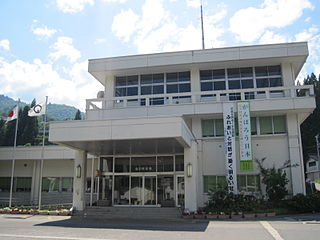
Shirakawa is a village located in Ōno District, Gifu Prefecture, Japan. It is best known for being the site of Shirakawa-gō, a small, traditional village showcasing a building style known as gasshō-zukuri. Together with Gokayama in Nanto, Toyama, it is one of UNESCO's World Heritage Sites.

The Shimanto River is a river in western Kōchi Prefecture, Japan. 196 km in length, it has a watershed of 2,270 km².

The Ibi River is a tributary of the Kiso River located in Gifu and Mie Prefectures in Japan. Along with the Nagara and Kiso rivers, the Ibi is the third of the Kiso Three Rivers of the Nōbi Plain. It is one of Japan's first-class rivers. The former Tōkaidō post station of Kuwana-juku was located on the western banks of this river during the Edo period.
The Hietsu earthquake was a doublet earthquake that took place on April 9, 1858. It most likely occurred on the Atotsugawa and Miboro faults, which connect the Amō Pass in Gifu Prefecture and Mount Tate in Toyama Prefecture on the island of Honshū in Japan. Its name includes one kanji from Hida (飛騨国) and one from Etchū (越中国). The earthquakes are estimated to have killed 200–300 people. It also caused the Mount Tonbiyama landslide and blocked the upper reaches of the Jōganji River.

The Shō River has its source in Mount Eboshi in the Shōkawa-chō area of Takayama, Gifu Prefecture, Japan. After flowing for 115 km (71 mi) through the northern part of Gifu Prefecture and the western part of Toyama Prefecture, it empties into Toyama Bay.

Kuguno Dam is a dam in Takayama, Gifu Prefecture, Japan, completed in 1962.

Nishidaira Dam is a hydroelectric dam in Ibigawa, in the Gifu Prefecture of Japan, completed in 1939.

Agigawa Dam is a dam built on the Kiso River system, located in the Higashino section of Ena City, in Gifu Prefecture, Japan.

The Hosobidani Dam (細尾谷ダム) is a dam in Hichisō, Gifu Prefecture, Japan, completed in 1926.
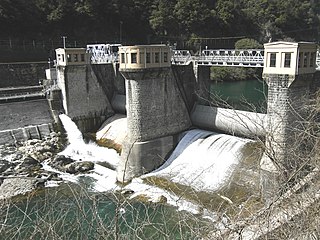
Kamiasō Dam is a dam in the Gifu Prefecture of Japan.

Kasagi Dam is a dam in the Gifu Prefecture of Japan. Construction of the dam was completed by 1936. Its height is 40.8m and its maximum power output is 41,700 kW.
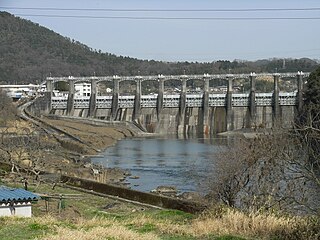
Kawabe Dam is a dam in Kawabe, Gifu Prefecture, Japan, completed in 1936.
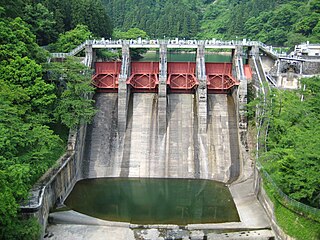
Kuze Dam is a dam in Ibigawa, Gifu Prefecture, Japan, completed in 1953.
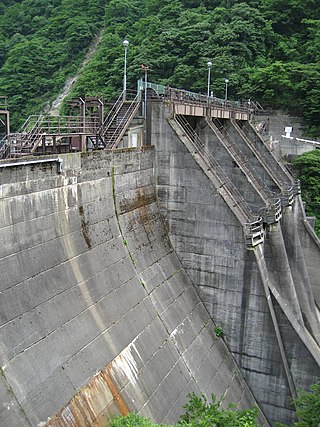
The Shin'inotani Dam is a dam in the city of Hida, Gifu Prefecture, Japan located on the Takahara River, part of the Jinzū River system. The dam is a concrete gravity dam with a height of 56 meters, and is operated by the Hokuriku Electric Power Company. The reservoir created is used by hydroelectric power generation for a total of 56,900 kW. The dam was completed in 1963.